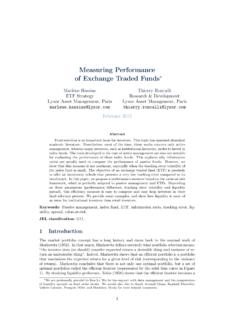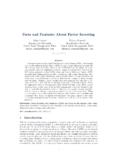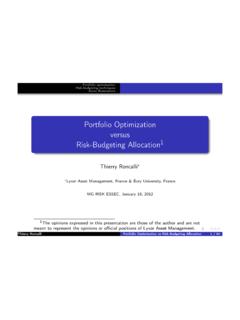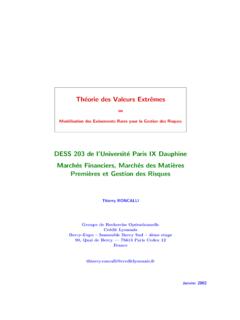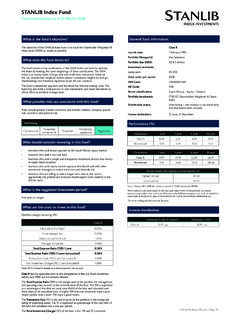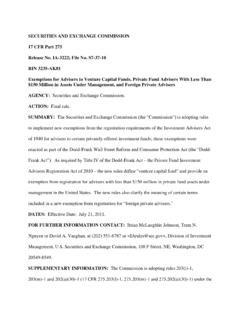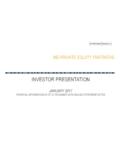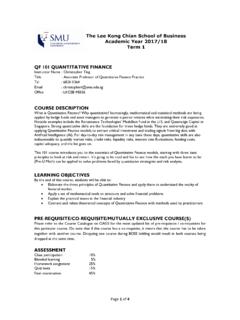Transcription of A Primer on Alternative Risk Premia - Thierry Roncalli
1 A Primer on Alternative Risk Premia Rayann HamdanQuantitative ResearchLyxor Asset Management, PavlowskyHedge fund ResearchLyxor Asset Management, New RoncalliQuantitative ResearchLyxor Asset Management, ZhengQuantitative ResearchLyxor Asset Management, 2016 AbstractThe concept of Alternative risk Premia can be viewed as an extension of the factorinvesting approach. Factor investing is a term that is generally dedicated to long-only equity risk factors. A typical example is the value equity strategy. Alternativerisk Premia designate non-traditional risk Premia other than long exposure to equitiesand bonds. They may concern equities, rates, credit, currencies or commodities andcorrespond to long/short portfolios.
2 For instance, the value strategy can be extendedto credit, currencies and commodities. This paper provides an overview of the differentalternative risk Premia to be found in the academic and professional spheres. Usinga database of commercial indices, we estimate the generic cumulative returns of 59alternative risk Premia in order to analyze their risk, diversification power and payofffunction. From this, it is clear that the term Alternative risk Premia encompassestwo different types of risk factor: skewness risk Premia and market anomalies. We thenreconsider portfolio allocation in light of this framework. Indeed, we show that skewnessaggregation is considerably more complex than volatility aggregation, and we illustratethat the volatility risk measure is less appropriate and pertinent when managing aportfolio with these risk Premia .
3 The development of Alternative risk Premia shallalso affect the risk/return analysis of non-linear strategies, hedge fund particular, using Alternative risk factors instead of traditional risk factors leads toan extension of the Alternative beta framework. Therefore, we apply the previouslyestimated risk Premia to a universe of hedge fund indices. To that end, we develop amodel selection based on the lasso regression to identify the most pertinent risk premiafor each hedge fund strategy. It appears that many traditional risk factors, with theexception of long equity and credit exposure on developed markets, vanish when weinclude Alternative risk : Alternative risk premium, factor investing, skewness risk premium, marketanomaly, risk factor, carry, event, growth, liquidity, low beta, low volatility, momentum,quality, reversal, value, short volatility, size, skewness, drawdown, diversification, portfolioallocation, option profile, Alternative beta, hedge classification:C50, C60, G11.
4 The authors are profoundly grateful to Gr egoire Vidal for his support with data management andJean-Charles Richard for his help on the graph should be addressed Primer on Alternative Risk Premia1 IntroductionOver the last few years, factor investing has grown in popularity and rapidly attractedasset managers and large institutional investors. Factor investing, together with Alternative -weighted indexation, defines the smart beta approach and is generally relevant to equityinvestment portfolios. The underlying idea is to capture equity risk factors, such as carry,low beta, momentum, quality, value and size. These risk factors are inconsistent with theCAPM theory (Sharpe, 1964), which defines a single risk premium.
5 But since CAPM wasintroduced, academic research has put forward convincing evidence that there are othersystematic sources of return (Fama and French, 1992; Carhart, 1997). The concept ofalternative risk Premia extends the factor investing approach by considering asset classesother than equities. For instance, the carry risk factor1can be defined using rates, currenciesor commodities. When applied to the volatility asset class, it corresponds to the shortvolatility an Alternative risk premium is a complex task. In a strict sense, an alternativerisk premium is a non-traditional risk premium2. In practice, Alternative risk Premia aresystematic risk factors that can help to explain the past returns of diversified may be risk Premia in a strict sense, but also market anomalies or common example is the momentum strategy, which is a market anomaly and not a risk risk factors are more difficult to classify.
6 For instance, the volatility carry risk factor,which corresponds to the short volatility strategy, is considered as a risk premium or amarket anomaly by different investors. In this article, we adopt accepted market practiceand use the term Alternative risk Premia to denote all systematic risk factors that haveresulted in positive performance in the traditional risk Premia , it is extremely difficult to isolate the performance of alter-native risk Premia . The reason is that this performance is dependent on several parameters,such as the asset universe, scoring method, weighting approach and trading implementa-tion. This is why most academics and professional researchers devise their own this article, we take another path: we compile a comprehensive database of about 2 000commercial indices and investment products, to replicate Alternative risk Premia .
7 By ap-plying discretionary due diligence and quantitative filtering, we are able to estimate thegeneric cumulative returns of 59 Alternative risk Premia . This estimation procedure showsthat some Alternative risk Premia are difficult to harvest, because investment products donot exist. Using these generic risk Premia , we can analyze them with a view to creating amore diversified portfolio than a portfolio of only traditional risk Premia . In particular, weexplore the nature of the relationship between managing volatility and skewness risks . Thesecond main application of these generic risk Premia is the analysis of hedge fund strategiesbased on the Alternative beta article is organized as follows.
8 In section two, we review the different conceptsrelated to Alternative risk Premia . Namely, these are risk factors, skewness Premia , marketanomalies and bad times. In section three, we present the process for identifying alternativerisk Premia and estimating their generic cumulative performance. Section four deals withthe issue of introducing Alternative risk Premia into an investment universe centered aroundtraditional assets and building a diversified portfolio. Applying Alternative risk Premia tothe risk/return analysis of hedge fund strategies is explained in section five. Finally, sectionsix offers our concluding the case of equities, this factor can be captured by investing in a portfolio of high dividend means that it is not a long-only exposure on equities or Primer on Alternative Risk Premia2 Defining risk Premia , risk factors and market anoma-liesIn this section, we review the different concepts related to Alternative risk Premia .
9 Moreprecisely, we clarify the definition of risk premium and explore the relationship betweenrisk Premia and risk factors. We also illustrate the blurred boundary between risk premiaand market anomalies. We adopt a very simple approach by focusing on the most importantresults, and refer to Cochrane (2001) and Martellini and Milhau (2015) for a comprehensivetreatment of these Defining the risk premium in the CAPMThe capital asset pricing model (CAPM) was introduced by Sharpe in 1964, and may beviewed as an equilibrium model based on the framework defined by Markowitz (1952). Inhis paper, Markowitz developed the efficient frontier concept, the set of optimal mean-variance portfolios.
10 Later, Tobin (1958) showed that the efficient frontier becomes a straightline in the presence of a risk-free asset. Contrary to Markowitz results, it can then be shownthat there is only one optimal portfolio of risky assets, which is called the tangency of the issues is that the tangency portfolio depends on the parameter values3of eachinvestor. This was partially solved by Sharpe (1964). Using a defined set of assumptions4,he showed that the tangency portfolio corresponds to the market-capitalization portfolio(or market portfolio). He then deduced the now familiar relationship between the expectedreturn of assetiand the expected return of the market portfolio:E[Ri] Rf= mkti(E[Rmkt] Rf)(1)whereRiandRmktare the asset and market returns,Rfis the risk-free rate and thecoefficient mktiis the beta of assetiwith respect to the market portfolio: mkti=cov (Ri,Rmkt) 2(Rmkt)Contrary to idiosyncratic risks , systematic risk cannot be diversified and investors arecompensated for taking this risk.
